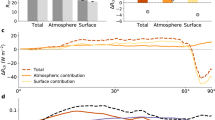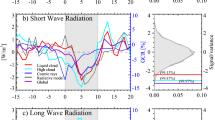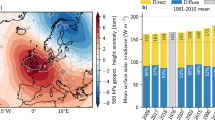Abstract
ANTHROPOGENIC depletion of ozone in the lower stratosphere has been of global environmental concern for two decades, but the environmentally relevant quantity—the flux of solar ultraviolet radiation (UVR) reaching the Earth's surface—remains poorly quantified on a global basis. The three most important parameters governing surface UVR fluxes and trends are solar elevation, total vertically integrated ozone abundance and cloud opacity. Here we use global satellite measurements of total ozone abundance and cloud reflectance to examine how the trends in UVR resulting from established trends in total ozone abundance1,2 compare with the potentially large natural variability in UVR that results from variations in cloud opacity. We find that throughout many temperate regions—including large parts of continental Europe, North and South America, New Zealand, Australia and southern Africa—interannual variability in cloud opacity is sufficiently small that by the end of this century, trends in summer average local-noon UVR dose rates relevant to mammalian skin cancer or plant damage should be significant with respect to cloud variability.
This is a preview of subscription content, access via your institution
Access options
Subscribe to this journal
Receive 51 print issues and online access
$199.00 per year
only $3.90 per issue
Buy this article
- Purchase on Springer Link
- Instant access to full article PDF
Prices may be subject to local taxes which are calculated during checkout
Similar content being viewed by others
References
Bojkov, R., Bishop, L., Hill, W. J., Reinsel, G. C. & Tiao, G. C. J. geophys. Res. 95, 9785–9807 (1990).
Niu, X., Frederick, J. E., Stein, M. L. & Tiao, G. C. J. geophys. Res. 97, 14661–14669 (1992).
Stolarski, R. S., Bloomfield, P. & McPeters, R. D. Geophs. Res. Lett. 18, 1015–1018 (1991).
Ramanathan, V. et al. Science 243, 57–63 (1989).
Joseph, J. H., Wiscombe, W. J. & Weinman, J. A. J. atmos. Sci. 33, 2453–2459 (1976).
Li, Z. & Garand, L. J. geophys. Res. 99, 8335–8350 (1994).
Briegleb, B. P. J. geophys. Res. 97, 7603–7612 (1992).
Wittmeyer, I. L. & Vonder Haar, T. H. J. Clim. 7, 326–333 (1994).
Lubin, D., Ricchiazzi, P., Gautier, C. & Whritner, R. H. in Ultraviolet Radiation in Antarctica: Measurements and Biological Effects (eds Weiler, S. & Penhale, P.) 53–81 (Antarctic Res. Ser. Vol. 62, Am. Geophys. Union, Washington DC, 1994).
Madronich, S. in Environmental UV Photobiology (eds Young, A. R., Björn, L. O., Moan, J. & Nultsch, W.) 1–39 (Plenum, New York. 1993).
Cole, C. A., Forbes, D. & Davies, R. E. Photochem. Photobiol. 43, 275–284 (1986).
Quaite, F. E., Sutherland, B. M. & Sutherland, J. C. Nature 358, 576–578 (1992).
Frederick, J. E. & Lubin, D. J. geophys. Res. 93, 3825–3832 (1988).
Eck, T. F., Bhartia, P. K. & Kerr, J. B. Geophys. Res. Lett. 22, 611–614 (1995).
Gleason, J. F. et al. Science 260, 523–526 (1993).
Brühl, C. & Crutzen, P. J. Geophys. Res. Lett. 16, 703–706 (1989).
Lubin, D. et al. J. geophys. Res. 97, 7817–7828 (1992).
Stamnes, K., Slusser, J., Bowen, M., Booth, C. R. & Lucas, T. Geophys. Res. Lett. 17, 2181–2184 (1990).
Seckmeyer, G. et al. Geophys. Res. Lett. 22, 1889–1892 (1995).
Madronich, S. Geophys. Res. Lett. 19, 37–40 (1992).
Blumthaler, M. & Ambach, W. Science 248, 206–208 (1990).
Liou, K. N. Radiation and Cloud Processes in the Atmosphere 305–307 (Oxford Univ. Press, 1992).
Pilewskie, P. & Valero, F. P. J. Science 267, 1626–1629 (1995).
Li, Z., Barker, H. W. & Moreau, L. Nature 376, 486–490 (1995).
Ramanathan, V. & Collins, W. Nature 351, 27–32 (1991).
Author information
Authors and Affiliations
Rights and permissions
About this article
Cite this article
Lubin, ., Jensen, E. Effects of clouds and stratospheric ozone depletion on ultraviolet radiation trends. Nature 377, 710–713 (1995). https://doi.org/10.1038/377710a0
Received:
Accepted:
Issue Date:
DOI: https://doi.org/10.1038/377710a0
This article is cited by
-
Surface ocean current variations in the North Pacific related to Arctic stratospheric ozone
Climate Dynamics (2022)
-
Solar UV-B/A radiation is highly effective in inactivating SARS-CoV-2
Scientific Reports (2021)
-
Improved Global Surface Temperature Simulation using Stratospheric Ozone Forcing with More Accurate Variability
Scientific Reports (2018)
-
An advanced impact of Arctic stratospheric ozone changes on spring precipitation in China
Climate Dynamics (2018)
-
UVA and UVB Penetration in the Water Column of a South West Atlantic Warm Temperate Estuary and its Effects on Cells and Fish Larvae
Estuaries and Coasts (2015)
Comments
By submitting a comment you agree to abide by our Terms and Community Guidelines. If you find something abusive or that does not comply with our terms or guidelines please flag it as inappropriate.



